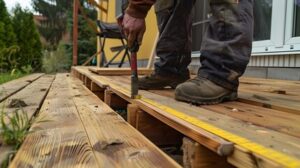Decks take a beating from sunlight, rain, snow and other elements. Deterioration is to be expected, but regular inspections allow homeowners to spot problems and make necessary repairs.

Minor cracks and popped nails are easy fixes for homeowners with basic DIY experience. However, if a deck is severely damaged or unsafe, a replacement is usually a better option. For professional help, contact Stafford VA Deck Builders.
Deck repair costs can be expensive, depending on the scope of the work required and the deck’s materials. The location of the deck, whether in an urban or rural area, also influences labor and material costs. Homeowners should factor in any applicable taxes or fees that may be added to the total cost of the project. It is also wise to consider any additional features or customizations that might be needed, such as railings, misters, pergolas, and kitchens, since these will increase the overall price of the project.
Often, the first sign that it is time to repair or replace a deck is splintering or cracking. If these issues have become widespread, a professional can help resolve them by repairing or replacing affected boards and re-staining the surface of the deck. In many cases, these types of repairs are not costly and will restore the deck to a safe level.
Another common issue that might necessitate a deck repair is rot. This is a serious structural problem that can affect the safety and integrity of the deck. Often, rot is caused by water or moisture soaking into the wood and damaging it. It can spread quickly, requiring extensive and costly repairs to the deck. In some cases, it might be more cost-effective to replace the entire deck than to spend hundreds or even thousands of dollars attempting to repair and save a damaged one.
If a deck is sagging or uneven, it is not safe to use and requires professional attention. This type of problem could be caused by rotting, weakened joist hangers, or other structural problems that can’t be addressed through repair. In these cases, a professional can help determine whether or not a replacement is necessary and make recommendations to ensure a safe deck.
Other indicators that a deck needs a repair or replacement include a spongy feel underfoot or soft areas where the deck is located. It is also important to look for corroded joist hangers, which could indicate that the supporting beams are in need of repair or replacement.
Materials
As with any home improvement project, the cost of materials can significantly increase the price of a deck repair. This is particularly true for larger projects, such as resurfacing and replacing the deck boards or building a new railing system. For these reasons, it is important to compare quotes from different contractors and ask for discounts. Some companies may offer military or senior discounts, while others will provide a discount for buying in bulk. If you can, shop around to find the best deal on decking materials.
Aside from the cost of materials, there are other costs to consider when repairing a deck. These include the cost of demolition and disposal fees. In some cases, it may be cheaper to replace the entire deck instead of repairing the individual parts of the structure. This is especially true if the damage is extensive or the structure is unstable.
The most common reason for rot is water damage, which can be caused by a variety of factors. Even pretreated wood can rot from prolonged exposure to moisture. If the rot is not repaired right away, it can spread quickly and lead to structural damage. Another common cause of rot is a nail or screw that has been driven into pressure-treated wood. These metals are susceptible to oxidation and can create a chemical reaction that rots the surrounding area.
In addition to the costs of materials, homeowners should also consider the cost of any applicable taxes or fees. This can vary from state to state, so it is important to research the specific requirements for your location before beginning a deck repair project. Some areas require permits, while others do not.
While composite decking is a durable material, it can still be scratched by items such as garden furniture or pets. In many cases, these scratches can be repaired using composite decking filler or wax. However, some scratches and gauges may be too severe to be fixed with these methods. In this case, the Board will need to be replaced.
When repairing Composite Boards, it is recommended that you test the colour of the repair product before proceeding. Mix a small amount of the dry repair material with water and compare it to your wet existing surface. This will allow you to match the colour and make sure it blends in well.
Design
When it comes to deck repair, there are many options available. However, you may be unsure about whether it’s more cost-effective to go with repairs or to replace your entire deck. Choosing the right option can help you save money and extend your deck’s lifespan.
The best way to determine which option is better for you is to assess the current condition of your deck. A common problem is moisture damage, which can lead to splintering, cracking, or warping. If you notice any of these problems, it’s time to contact a professional for deck repair.
Another problem that indicates it’s time for deck repair is unstable footings. This is often caused by soil erosion and may be a result of frost heave or excessively wet soil conditions. Deck repair professionals can help you reduce soil erosion and divert water flow to prevent footing instability.
You can also determine if your deck is due for a reseal by testing its ability to retain moisture. To test this, sprinkle a little water on your deck and watch to see if it beads or soaks in. If it does, it’s time to reseal your deck.
Another sign that it’s time for a reseal is if your deck boards are starting to show signs of fading or discoloration. This usually occurs with wooden decks and can be repaired by re-painting or re-staining. However, if the damage is severe and widespread, it’s likely best to replace your deck to ensure safety and compliance with building codes.
One last issue that could indicate a need for deck repair is damage to the ledger board, which attaches your deck to your home. This is a serious safety concern and can cause major structural issues if not addressed immediately.
A good deck repair should include a full clean to remove dust, mildew, and other debris. This is essential to allow you to get a clear view of any issues that might be hiding under dirt and clutter. You should also replace any missing or faulty fasteners. Using modern, composite or PVC fasteners can help ensure that your deck will be safe and secure for years to come.
Installation
A deck is a great addition to any home, but it requires regular maintenance to keep it in good shape. When the deck starts to deteriorate, it may need to be replaced entirely. Luckily, deck repair is often less expensive than a replacement, and it is more effective at improving the appearance of a deck. Some of the most common issues include splinters, discoloration, and mold growth. However, minor damage can be resolved by cleaning and staining the affected areas.
One of the most common signs that a deck needs repair is if its wood support posts or beams start to rot. This is a serious issue, because it can affect the structural integrity of the entire deck and even your home.
If the problem is limited to a small section of the deck, it can usually be fixed with a few new support beams and joist hangers. However, if the problem is widespread and you’re concerned about the safety of your deck, it’s probably time to call in an expert.
Another important sign of a damaged deck is if the boards are loose or wobbly. Loose boards are easy to fix by tightening the fasteners and replacing any faulty ones. This can be done in a day or two and is relatively inexpensive.
Some problems with a deck are more severe and require a complete replacement, including a sagging structure and rotting boards. These problems are often the result of a failing deck foundation, and can lead to a collapsed structure. If the deck has been infested with termites, it’s likely that the wood will need to be completely replaced.
The cost of deck repair depends on the severity of the damage and the materials used. Generally, smaller decks made of cheap material are less expensive to repair than larger decks made from more expensive materials. The average square foot cost of a deck repair is $10-$50, and costs vary depending on the type of materials used.
In addition to the cost of repairs, homeowners should be prepared for any applicable taxes and fees. For example, a homeowner who is installing a new deck might be eligible for an energy tax credit. It’s also a good idea to save all receipts for labor and materials, as these can be claimed as a tax deduction or credit.








